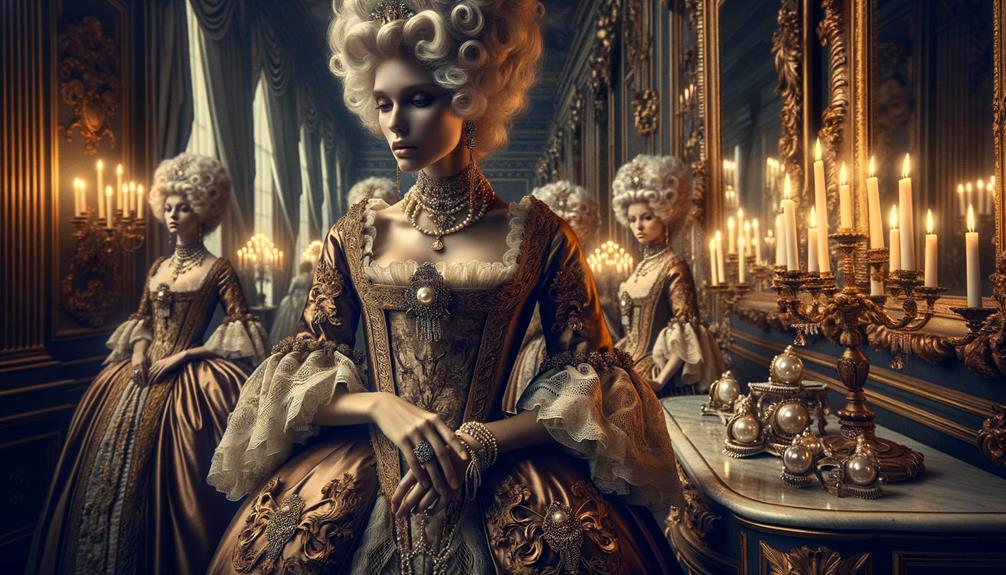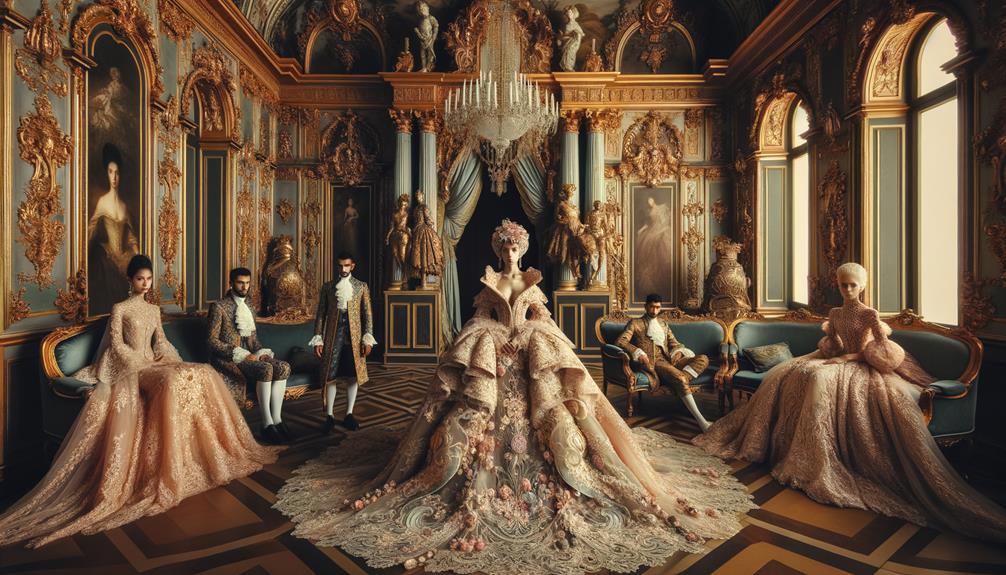The Baroque and Rococo periods in art history may seem like obscure footnotes, but their influence runs deeper. These eras used visual flair to make bold statements about the times. Baroque's dramatic chiaroscuro and dynamic forms contrast sharply with Rococo's pastel palette and playful elegance. These aren't just stylistic choices; they're cultural commentaries.
Artists like Caravaggio and Fragonard manipulated light and form to reflect power dynamics, religious themes, and societal shifts. Exploring how these art styles shaped perceptions and mirrored the era can provide fascinating insights. The Baroque's intense contrasts and the Rococo's lighthearted charm each offer a window into the worldviews and preoccupations of their respective eras.
Origins of Baroque Art
Baroque art emerged around 1600 in Rome, driven by the Catholic Church's desire to evoke strong emotions and sensory experiences. Seeking to counter the growing influence of Protestantism, the Church turned to art to reassert its power and wealth. This led to the development of the Baroque style, characterized by dramatic lighting, exaggerated motion, and intense emotional expression.
The way Baroque paintings captivate viewers is intriguing. Artists like Caravaggio utilized the chiaroscuro technique, creating stark contrasts between light and shadow to heighten the emotional impact. Masters such as Rubens employed illusionistic techniques that added depth, making the scenes appear almost tangible.
Baroque architecture also reflected this sense of grandeur. Structures in Roman Catholic countries featured bold spaces, extensive decorative elements, and awe-inspiring domes. The architecture wasn't just about function; it was about creating an immersive experience that would leave the viewer in awe. Bernini's work on St. Peter's Basilica exemplifies this, with its grandiose scale and intricate details.
This blend of art and architecture under the Baroque style was more than just aesthetics. It was a calculated move by the Catholic Church to touch the hearts and minds of the faithful, reaffirming its presence during a turbulent time.
Key Characteristics of Baroque
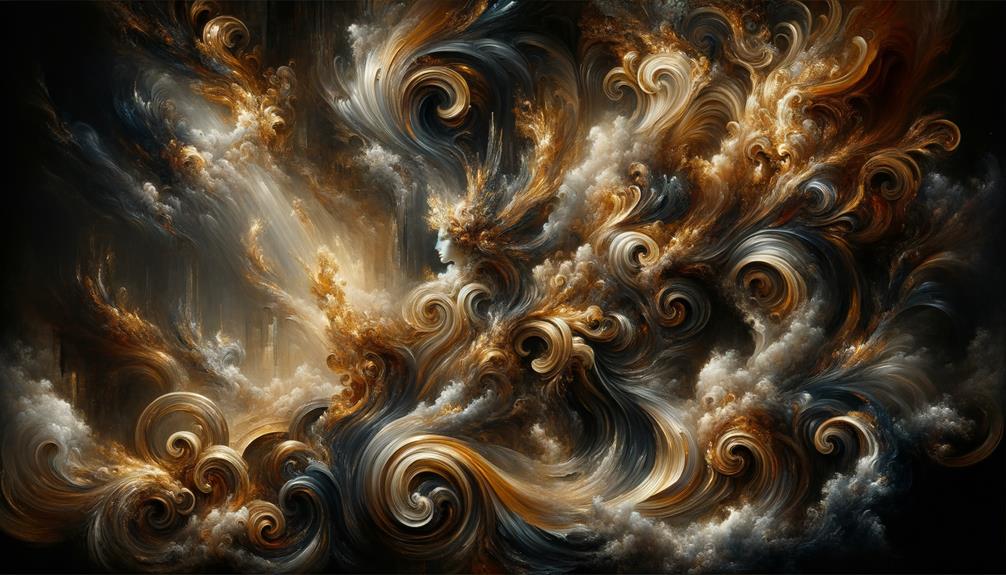
Baroque art was renowned for its dramatic flair and emotional intensity. Artists of the time used techniques like chiaroscuro – the interplay of light and shadow – to create a palpable sense of energy and movement in their works. Bernini's sculptures, for instance, seemed to capture frozen moments of intense emotion, as if the figures were coming alive before the viewer's eyes.
The architects of the Baroque era also embraced grandeur and spectacle. Stepping into a Baroque church, one couldn't help but feel a profound sense of the divine – every curve and decoration seemed designed to uplift the soul. This style was actively employed by the Catholic Church during the Reformation, as a way to reinforce faith and make the sacred experience almost theatrical.
| Element | Technique | Purpose |
|---|---|---|
| Painting | Chiaroscuro | Create dramatic effect |
| Sculpture | Dynamic Composition | Evoke emotional response |
| Architecture | Grandiose Design | Evoke a sense of the infinite |
| Patronage | Catholic Church | Promote Catholic faith |
Baroque art was not merely about aesthetics; it was a strategic response to the theological upheaval of the Reformation. The dramatic effects, the emotional intensity – these were tools used to draw people back to the Church. This was no mere decoration; it was persuasion through the power of artistic expression. The Baroque era was a time when art and purpose were inextricably linked.
Prominent Baroque Artists
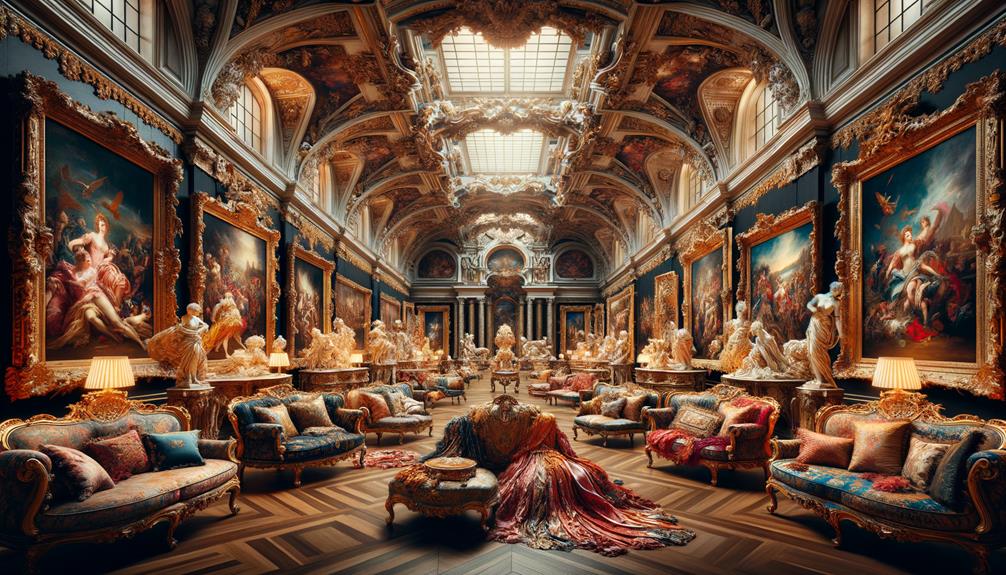
When we think of Baroque art, we can't ignore the captivating work of Caravaggio and Rubens. Caravaggio's use of dramatic lighting creates a profound intensity in his scenes. Rubens, on the other hand, draws us in with his vibrant energy and fluid forms.
Caravaggio's Dramatic Lighting
Caravaggio's use of dramatic lighting, characterized by stark contrasts of light and shadow, brings a palpable intensity to his figures. This chiaroscuro technique, central to Baroque art, amplifies the psychological tension in his works. Light and dark aren't just visual elements; they're emotional conduits.
Caravaggio's unorthodox religious depictions challenge traditional iconography, as seen in 'Bacchus' and 'Boy with a Basket of Fruit.' The interplay of light and shadow creates a heightened emotional state, drawing viewers into the scene.
His pioneering use of tenebrism, which focuses intense light on a single figure, influenced subsequent Baroque painters. In 'Bacchus,' a lone figure emerges from a dark background, bathed in an almost divine light. The stark contrast intensifies the viewer's focus on Bacchus's expression, a blend of sensuality and melancholy. Similarly, in 'Medusa,' the dramatic lighting makes the mythological subject's horror palpable, frozen in a moment of terror.
Caravaggio's methods conveyed deeper narratives, blending the sacred and the secular. His revolutionary approach to light and dark remains an enduring influence in both religious and secular art. The emotional restraint in his works invites us to explore human vulnerability through a Baroque lens.
Rubens' Dynamic Compositions
While Caravaggio's dramatic lighting set a somber tone, Rubens' paintings burst with vibrant energy and movement. His Baroque works, like 'The Descent from the Cross' and 'The Raising of the Cross,' showcase this. Rubens' art is a whirl of color and motion, where thick, fluid brushstrokes capture the sensuality of the human form. Each figure in his compositions appears caught in a moment of intense action or emotion.
Rubens was heavily influenced by the Italian Renaissance masters, taking in the grandeur of Michelangelo and the rich color palette of Titian. This influence is evident in his complex, multi-figure compositions, which often depict religious, mythological, or allegorical themes. His ability to convey narrative through dynamic arrangement and vigorous brushwork set him apart in the Baroque era.
The Catholic Church and European royalty greatly admired and collected Rubens' work, drawn to his lush, painterly technique and the emotional resonance of his subjects. In Northern Europe, Rubens played a pivotal role in the development of the Baroque style, blending Renaissance inspiration with his unique, energetic approach to painting. His legacy is one of vivacity and innovation.
Rise of Rococo Style
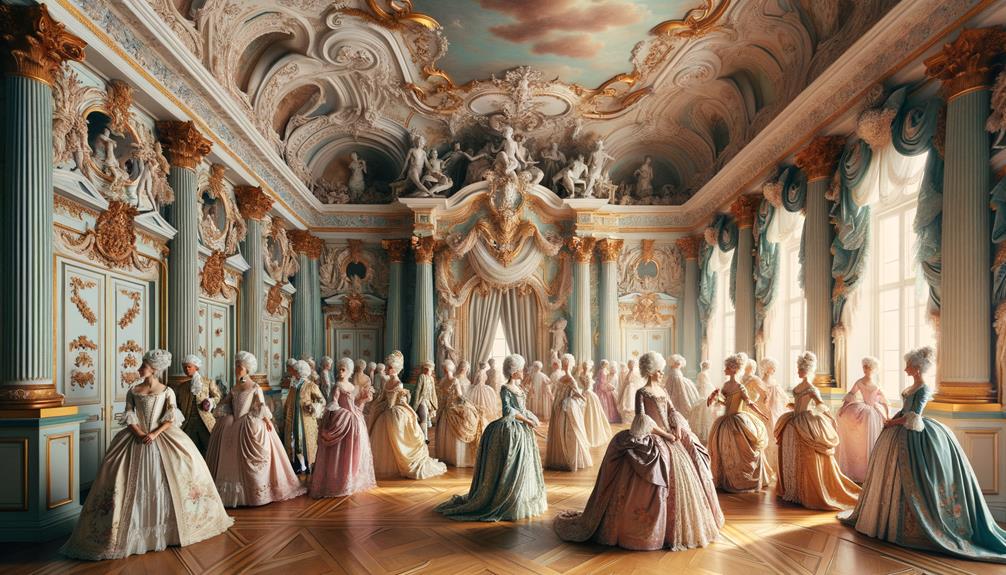
The Rococo style, emerging in early 18th century France, marked a departure from the intensity of the Baroque era. This new artistic approach embraced a sense of lightness and elegance. Rococo art, with its delicate and playful nature, shifted French art away from the grandiosity characteristic of the Baroque period. Under the reign of Louis XV, Rococo architecture and interiors flourished, featuring asymmetrical designs and soft pastel hues.
Rococo art focused on themes of romance and mythology, offering a glimpse into the lives of the elite. This contrasted starkly with the heavy religious and political symbolism of the Baroque style. The shift from Baroque to Rococo mirrored the cultural and philosophical changes of the Enlightenment, emphasizing personal enjoyment and aesthetic pleasure.
Key features of the Rococo style:
- Architecture: Notable for its whimsical, organic forms and intricate ornamentation.
- French art: Evolved under Louis XV, reflecting a more personal and intimate approach.
- Transformation: Marked a significant shift in art, moving from dramatic intensity to playful elegance.
This evolution in style, from Baroque to Rococo, not only enriched the visual arts but also mirrored the broader societal shifts of the time, encapsulating a period of transformation and innovation.
Defining Rococo Features
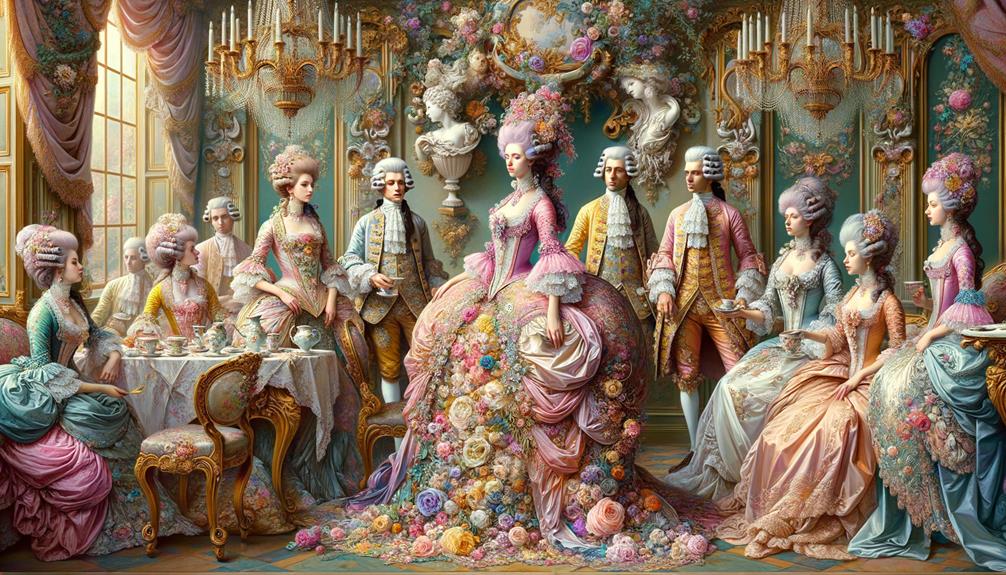
Rococo art captures a playful elegance, with its lightness and whimsy. Emerging in early 18th century France, Rococo reflects the growing power and wealth of the French aristocracy. Unlike the grandeur of Baroque art, Rococo is characterized by its delicacy and grace. The art and architecture of this period are filled with light, airy qualities, favoring pastel colors and asymmetrical compositions.
Rococo interiors are intimate, adorned with intricate, curving ornamentation. The architecture seeks to create a sense of fantasy, a departure from the more dramatic and ornate Baroque style. This shift is evident in the way Rococo designs emphasize intimacy and pleasure over spectacle.
In paintings, scenes of upper-class social life abound, celebrating themes of love, beauty, and pleasure. Romantic and mythological scenes are common, depicted with a light touch that avoids heavy-handedness. The use of soft colors and playful elements creates a sense of whimsy, inviting viewers into a world of elegance and fantasy.
Fundamentally, Rococo is about capturing the essence of light. It's an art form that seeks to delight, to entertain, and to evoke a sense of effortless beauty.
Influential Rococo Figures
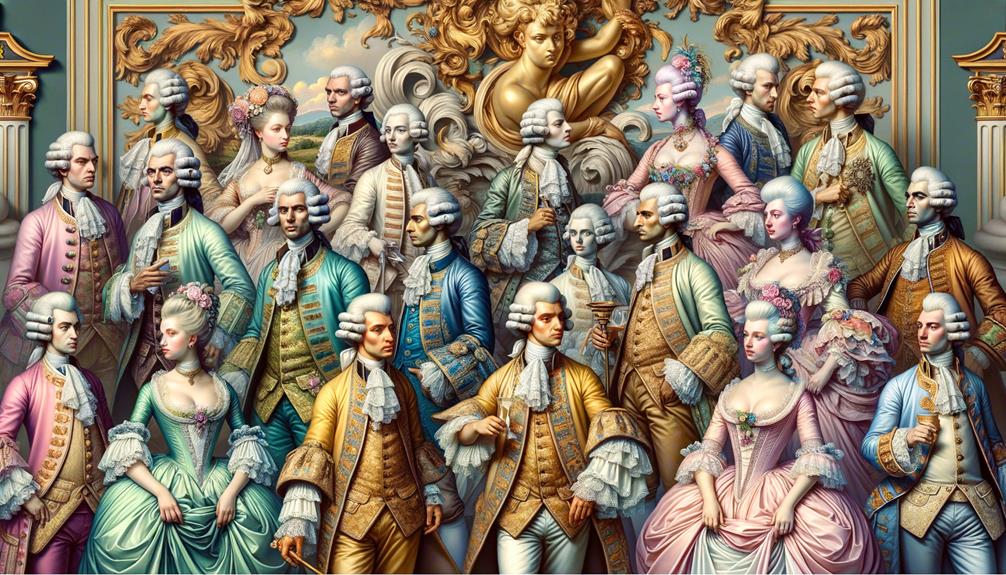
When it comes to Rococo art, three figures stand out for me: Watteau, Boucher, and Fragonard. Each artist captured a different aspect of this lavish period. Watteau's works exude a playful elegance, Boucher's paintings depict pastoral scenes, and Fragonard's art embodies a sense of romanticism. Their creations breathe life into the Rococo's spirit of leisure and fantasy.
Watteau's paintings are marked by a lighthearted and graceful style. Boucher, on the other hand, is known for his idyllic countryside landscapes. Fragonard, meanwhile, embraced the Rococo's romantic sensibilities in his art. Together, these three figures represent the diverse facets of the Rococo movement.
Antoine Watteau's Playful Elegance
Antoine Watteau's art captures the whimsy and sophistication of aristocratic leisure. His delicate brushwork and soft palettes bring to life scenes of courtship and relaxation in his signature genre, the fête galante. The Rococo spirit shines through in his use of pastel colors and graceful brushstrokes, creating idealized depictions of aristocratic life.
Watteau's mastery lies in his ability to infuse a sense of delicacy and charm into each figure. His characters, often adorned in lavish costumes, move through dreamlike landscapes with an ethereal quality. This world of elegance and playfulness feels both distant and strangely familiar.
The fête galante genre, Watteau's trademark, portrays idyllic scenes of aristocratic leisure. His palette of soft hues enhances the dreamlike quality of his works, while his graceful brushwork lends a sense of movement and vitality to the figures.
Watteau's art signifies a shift from the grandeur of the Baroque, embracing a more intimate and lighthearted approach. His influence extended beyond painting, shaping Rococo interior design and decorative arts across Europe. Each piece embodies an idealized vision, a fleeting moment of courtly delight captured forever. Watteau's legacy endures, a lasting testament to the power of subtlety and grace.
François Boucher's Pastoral Scenes
François Boucher's pastoral scenes capture the carefree essence of 18th-century aristocratic life with a delicate touch. His Rococo paintings, like 'The Swing' and 'Leda and the Swan,' present an idealized world, where mythological and elite figures revel in lush, whimsical landscapes. Boucher's style emphasizes grace and delicacy, contrasting the grandeur of Baroque art. The soft pastel colors and asymmetrical compositions he uses evoke a sense of playfulness.
In Boucher's work, we see the influence of Antoine Watteau's playful elegance, but Boucher's scenes are more sensual, sometimes erotic. His Rococo art reflects the sophistication and leisure of the French aristocracy under King Louis XV. Each brushstroke seems to capture the French 'joie de vivre.'
Boucher's pastoral scenes offer a window into a world of refined pleasure and nature's embrace. They speak to an audience that values innovation and seeks beauty in the ephemeral. In his art, the boundaries between reality and fantasy blur, offering a vision of life that is both enchanting and serene. Boucher remains a quintessential figure in Rococo art, defining its essence with every stroke.
Jean-Honoré Fragonard's Romanticism
Jean-Honoré Fragonard's art captures the whimsical and indulgent spirit of 18th-century aristocratic life. His Rococo masterpieces, like "The Swing," depict a world of playful decadence. The scene, with a young woman soaring high, an older man pushing her, and a cupid looking on, epitomizes the Rococo's fixation on love and leisure.
Fragonard's style is instantly recognizable. His loose, energetic brushwork creates a sense of movement and spontaneity. The vibrant colors he used bring a lush, almost tangible quality to his canvases. Each stroke seems deliberately placed to enhance the decorative appeal. His works often:
- Feature mythological and allegorical themes, blending fantasy with contemporary aristocratic life.
- Prioritize visual pleasure, focusing on elegance and escapism rather than moral or historical gravitas.
- Capture the essence of Rococo elegance, emphasizing gracefulness and a light-hearted touch.
Observing Fragonard's paintings, one can't help but notice how they diverge from the gravity of Baroque art. There's an emotional restraint, a focus on surface beauty and charm. Fragonard's work offers a lens to view Rococo's playful rebellion against the constraints of everyday life.
Frequently Asked Questions
What Are the Characteristics of Baroque and Rococo Fashion?
Baroque fashion is dramatic and ornate, with rich embroidery. Rococo fashion, on the other hand, is more delicate and pastel, featuring floral motifs.
Baroque fashion highlights power, while Rococo fashion reflects a more lighthearted, leisurely attitude. Baroque uses chiaroscuro (the interplay of light and shadow) to create depth, while Rococo fashion is more decorative in nature.
This shift in fashion mirrored the cultural transition from the grandiose to the more whimsical. Baroque's opulence gave way to Rococo's playfulness, reflecting the changing values and aesthetics of the time.
What Is the Difference Between Baroque and Rococo Style of Painting?
Baroque paintings tend to be dramatic, with intense contrasts and dynamic energy. In contrast, Rococo art is lighter, more playful, featuring soft pastel colors and whimsical themes. Baroque works often feel powerful and grand, while Rococo paintings have a more delicate and leisurely quality.
What Best Describes the Baroque and Rococo Styles?
The Baroque and Rococo styles offer a striking contrast. Baroque art is known for its dramatic, grand style, often depicting religious themes. In contrast, Rococo art is characterized by its light, playful elegance, favoring secular subjects. Both styles, however, share a penchant for opulence and intricate details, each reflecting the cultural zeitgeist of its era.
What Is the Rococo Style in Painting and Architecture?
The Rococo style in painting and architecture emphasizes delicacy, charm, and playful themes. Paintings often feature pastel colors and intimate, whimsical scenes. Architectural designs are intricate and ornamental, with a focus on asymmetry and a sense of fantasy. This style is both lighthearted and refined, creating an overall impression of elegance and imagination.
Conclusion
Baroque art's dramatic flourishes eventually gave way to Rococo's more delicate aesthetic. The shadows and intensity of the Baroque era receded, replaced by a softer, more playful approach featuring pastel hues. From the grand cathedrals to the intimate boudoirs, these artistic styles mirrored the worlds they inhabited. Baroque's fervent brushstrokes conveyed a sense of zeal, while Rococo's playful touches evoked luxury. Tracing the evolution of these eras, we witness art's power to shape, reflect, and captivate the sensibilities of its time.



